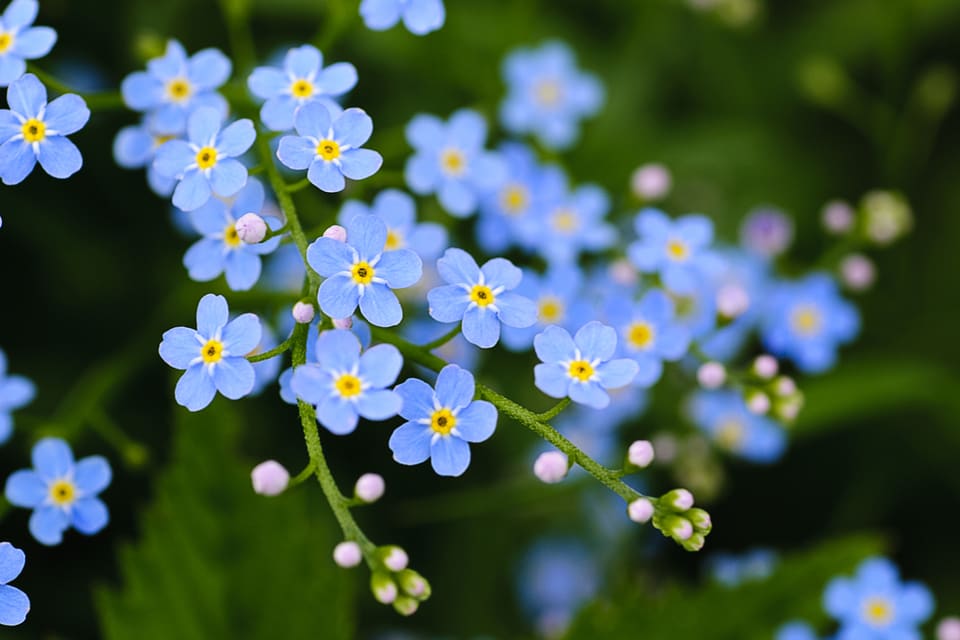
Dementia Flowers and Badges As Symbols of Hope

Flowers have long been seen as a sign of renewal and hope, blossoming each spring after the winter cold fades. They’re also viewed as gestures of love when delivered on birthdays or anniversaries and are used as tokens of grief when sent to those in mourning. Because of these sentimental links, The Alzheimer’s Association created a distinct color-coding system that connects each personal relationship with dementia to a specifically colored flower.
Let our care assessment guide you
Our free tool provides options, advice, and next steps based on your unique situation.
These colorful dementia flowers bring optimism to those touched by this progressive illness. Each differently colored flower serves as a symbol of strength and represents one’s relationship with the disease:
- Blue, for those currently experiencing Alzheimer’s or another type of dementia.
- Purple, for those who’ve lost a loved one to dementia.
- Yellow, for caregivers.
- Orange, for anyone who believes in a future without dementia.
- White, to signify hope for a cure.
Some people choose to dedicate their time toward learning more about dementia by earning dementia flower badges or donating money to help to fund further research in hopes of one day finding a cure.
Read on to learn more about the meanings of different dementia flowers and badges and how they help organizations work toward a future without Alzheimer’s and other dementias.
In this article:
Dementia and its impact
More than 55 million people worldwide are currently living with dementia, according to the World Health Organization. Dementia is a general term for a decline in cognitive function, and it affects:
- Memory
- Judgment
- Comprehension
- Mood and behavior
- Physical functions essential to activities of daily living
While there are many different forms of dementia, Alzheimer’s disease is the most common type — accounting for up to 80% of cases, according to the Centers for Disease Control and Prevention (CDC). Forgetfulness and confusion are common symptoms that appear in the earliest stages of dementia and tend to become more pronounced over time. Dementia rates are increasing globally, so raising awareness is essential.
Symbols like dementia flowers and badges create positive associations that empower and acknowledge everyone touched by dementia. They also remind caregivers and families that they’re not alone in this fight.
Dementia flowers: colors and meanings
When a family member or a loved one receives an unexpected medical diagnosis, people often look for symbols that bring strength. Gestures, such as colorful ribbons and months of remembrance, create associations that help build awareness and bring attention to special causes.

Let our care assessment guide you
Our free tool provides options, advice, and next steps based on your unique situation.
Whether you are a dedicated caregiver, have lost a loved one to dementia, or are passionate about finding a cure, there is a dementia flower recognizing your commitment to the cause.
What each color of dementia flower represents
Each year, the Alzheimer’s Association hosts a Walk to End Alzheimer’s where participants receive flowers to carry during the walk. The colors of these dementia flowers have different meanings and associations.
- Blue flowers are meant to identify a person currently living with Alzheimer’s or another form of dementia.Often, specially designed buttons feature plain blue flowers with sayings such as, “Be patient with me. I have dementia.” These badges encourage patience as people interact with seniors affected by cognitive decline.
- Purple flowers are for those who have lost a loved one to dementia, memorializing their loss.The color purple has long been associated with Alzheimer’s and other types of dementia. The American Alzheimer’s Association uses purple as its signature color, describing the combination as blending “the calm stability of blue and the passionate energy of red.”
- Yellow flowers signify that a person is a caregiver.More than 16 million Americans are unpaid caregivers for loved ones with some form of dementia, according to the CDC. Dementia caregivers provide intensive support, dedicating a significant amount of time in addition to a high level of care. The yellow dementia flower is a way to identify caregivers and help proudly show their devotion.
- Orange flowers are for those who support the overall cause — the vision for a world without dementia — whether they have personal ties to dementia or not.
- White flowers are a recent addition to the color palette for dementia and signify hope for a cure.The Alzheimer’s Association debuted the white dementia flower during their 2019 Walk to End Alzheimer’s. Scientists and researchers continue to seek treatments to prevent or slow the progression of dementia. This white flower gives hope and power to dementia patients, their families, and caregivers.
A meaningful symbol: the forget-me-not flower
With its small blue petals, yellow center, and representative name, the forget-me-not flower has become a familiar symbol for Alzheimer’s disease and other forms of dementia. Forget-me-not flower pins and stickers are worn both by people with dementia and by those who want to raise awareness of the condition.
The Alzheimer’s Society sells a variety of forget-me-not themed merchandise in their online store, with 100% of proceeds going toward the fight against dementia.
Growing your own patch of forget-me-nots is a thoughtful way to honor a loved one with dementia. Packs of forget-me-not seeds are available for purchase online or from your local greenhouse.
From crochet patterns to personalized forget-me-not tattoos honoring loved ones, this well-known flower has become a powerful icon.
Educational and fundraising opportunities
Dementia care badges showcase an individual’s dedication to dementia education, enabling them to become advocates for the memory care community. While there is currently no cure for dementia, fundraising opportunities encourage gifts that go toward funding research for Alzheimer’s and other forms of dementia. These badges serve as symbols of inspiration:
- Dementia Friends badge. The Alzheimer’s Society developed the Dementia Friends program to educate and reframe people’s perceptions of dementia. You can become a Dementia Friend by watching a virtual information session that teaches viewers more about dementia, its effects, and how to support people with dementia in their community. After that, you’ll receive the Dementia Friends flower badge to wear proudly.
- Forget Me Not Appeal badge. The Forget Me Not Appeal is a fundraising effort from the Alzheimer’s Society that aims to provide support for people living with dementia. After donating, you’ll receive a forget-me-not flower badge to wear as a symbol of solidarity for those affected by the disease.

Talk with a Senior Living Advisor
Our advisors help 300,000 families each year find the right senior care for their loved ones.
Beyond symbols: support for caregivers
When caring for a loved one with dementia, it’s important to stay aware of your own mental and physical health. Learn more about support options through these resources:
- Understand the symptoms of caregiver burnout to know when to seek help.
- Learn more about the 7 stages of dementia to prepare for your loved one’s future.
- Join a caregiver support group to find others in a similar situation.
- Learn more about hiring part-time or permanent in-home help so you have time to relax and recharge while remaining close to your loved one.
- Talk to one of our free, expert Senior Living Advisors about respite or memory care options that may be right for you.
Sources
Alzheimer’s Association. Our story.
Alzheimer’s Association New Mexico Chapter. (2019). AlzAdvocate: Summer 2019 newsletter. Alzheimer’s Association.
Alzheimer’s Disease International.Dementia statistics.
Alzheimer’s Society. The forget me not appeal.
Alzheimer’s Society. Dementia friends.
Centers for Disease Control and Prevention. (2019, October 30). Caregiving for a person with Alzheimer’s disease or a related dementia. U.S. Department of Health & Human Services.
Senior living options in all states
The information contained on this page is for informational purposes only and is not intended to constitute medical, legal or financial advice or create a professional relationship between A Place for Mom and the reader. Always seek the advice of your health care provider, attorney or financial advisor with respect to any particular matter, and do not act or refrain from acting on the basis of anything you have read on this site. Links to third-party websites are only for the convenience of the reader; A Place for Mom does not endorse the contents of the third-party sites.
Make the best senior care decision
Make the best senior care decision